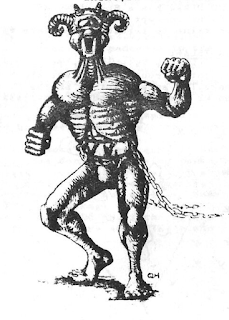Welcome to the eleventh entry in the series Original Scenarios Resurrected, wherein D&D scenarios from the 70s and early 80s are republished with the permission of the authors, usually together with extra contemporaneous material. Today is the turn of The Tower of Mrannor by Andrew Ravenscroft. For all entries in the series see here.
Andrew Ravenscroft has appeared a couple of times in this series - The Temple of Psaan, Clearwater Caverns, and The Devil's Quagmire. Of these, The Devil's Quagmire from The Beholder #16 was the most ambitious, detailing an accursed swamp dotted with atmospheric locations. The Devil's Quagmire was double the size of any of Andy's earlier published adventures, but even at 14 pages - half the fanzine - it is still very small compared to Andy's home campaign adventures.
 |
| Sketch of The Tower of Mrannor |
Not much remains of Andy's old D&D home campaign - but very fortunately his last adventure still survives. Tower of Mrannor is 93 pages of maps, keys, background and monster descriptions. It details the three levels of the tower itself, and four dungeon levels beneath (plus a sub level). For the fifth level you pass through an Interdimensional Gate into a huge wilderness area containing various separate adventuring locations, some of which themselves are multi-level. Further it contains gates into four planar adventures.
Mrannor is firmly rooted in the tradition of megadungeons: in history (it was created by an Evil Wizard), in location (it lies underneath the Wizard’s tower on an island), and in scope (256 rooms across 24 levels or areas spread over 12 pages of maps). But it is also definitely a megadungeon of the late 70s – it is not the minimalist monster + treasure style of the earliest examples. Of the two main strands in late 70s dungeon design, naturalistic and puzzle, it fits the naturalistic mould (think Against the Giants rather than White Plume Mountain).
It also marks the point in history where adventures were (in this case literally) escaping the confines of the dungeon. The move away from the dungeon as a prime focus of fantasy RPGs which started in the late 70s is clear but also difficult to nail down. When Brian Dolton in Demonsblood #4 in September ’79 says that his campaign doesn’t have any large dungeons, this is clearly viewed as something unusual.
Caverns of Thracia (Jaquays, 1979) included an ‘outdoors’
level – a palace in an underground garden lit with magical daylight. Mrannor
continues with the concept but takes it further – level five is an
interdimensional gate into a 200 square mile enclosed ‘universe’ powered by a
gem of planar stability. This level contains a number of different adventuring
locations, some of which may be familiar to readers of early D&D scenarios:
this enclosed ‘universe’ would escape and take on its own identity, becoming a
wilderness adventure The Devil’s Quagmire (The Beholder #16, July 1980 –
republished as Original Scenarios Resurrected VIII).
Mrannor was Andy’s last scenario for his Michael
Moorcock-inspired campaign, and the players made it as far as level five but
did not complete it. They “did just the Frost Giant scenario then they saw
the Bulette in the distance and bugged out of there in a hurry. It was the end
of the summer hols just before everyone headed off to uni, so my gaming group
dissolved at that point, and I never had the motivation to finish it.”
When Andy sent me the manuscript for the Tower of Mrannor he
had forgotten its relationship to The Devil’s Quagmire. As I was collecting and
reviewing the material I noted sadly that several of the locations for the
fifth level had been left uncompleted. The Pagoda (incorporating the Ogre
Mage's Lair) and The Frost Giant's Lair are both complete, and Level 5A is half
finished - but there was nothing for The Jetty and Outbuildings, House of Fear
(Mrannor's House), Standing Stone, Castell Knight's Tower, or Arioch Temple.
I put Tower of Mrannor aside as I worked on preparing other
scenarios for publication, and in time I came to work on The Devil's Quagmire.
As I got to the end I noticed the name of the last location, Arioch Temple, was
the same as that of one of the missing locations from Tower of Mrannor. It
suddenly became obvious in a flash - The Devil's Quagmire is Level
Five of Tower of Mrannor. The wilderness with its trails has been reduced to
about one-third size, and the quagmire itself introduced to persuade you to
keep to the paths. The Arioch Temple has remained the Arioch Temple, The House
of Fear has become The Charnel House, The Castell Knight's Tower has become The
Ruined Fort, and The Standing Stone has become The Pillar of the Three Tests.
Note that none of the locations which
reappeared in The Devil's Quagmire exist in The Tower of Mrannor manuscript
(only on the map) so it seems likely that the maps and keys for these locations
in Mrannor all existed at some point and were removed to assist in writing The
Devil's Quagmire (and subsequently lost). Since the only remaining missing
location in Mrannor is The Jetty and Outbuildings, it would be reasonable to
assume that this too was removed for use in The Devil's Quagmire - did it once
house the guardian that became the Keeper of the Rolls?
The Devil’s Quagmire is included at the end of this scenario
– you can either use the material from Devil’s Quagmire to complete The Tower
of Mrannor or use the material from level five to expand upon The Devils’s
Quagmire.
In addition, I have reconstructed two players handouts as described in the key, filled in a couple of missing key entries with the help of Andy’s recollections, added a side elevation map as an overview, and included a brief summary of all the monsters included from various fanzines and magazines.
.jpg)







